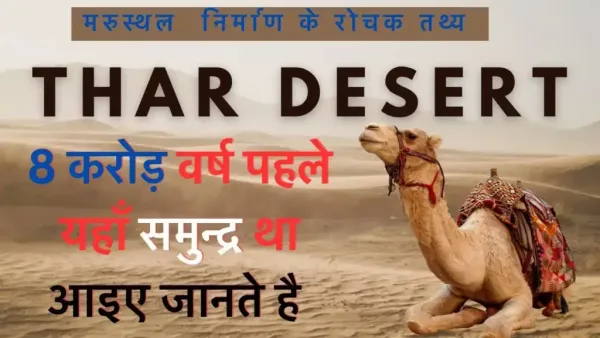
The Thar desert located in the western part of India, also known as the “Desert of Rajasthan”, is not only known for its vastness but also for its unique geography and cultural characteristics. The desert is spread over about 3,20,000 square kilometers and is also extended across the India-Pakistan border. The origin, history and cultural heritage of Thar makes it not only geographically, but also from historical and social terms.
https://www.youtube.com/watch?v=qx5zi8v1s
Construction of Thar: Story of an ancient Sagar
Scientists and geography believe that the present Thar desert was part of a huge ancient sea. The region was connected to the Arabian Sea millions of years ago. The soil, sand and rocks were formed here due to the gradual shrinking of the sea and the sediment. These sedes consisted of salts and minerals, making the form of climate and soil of the region gradually turned into desert form. Over time, the amount of rainfall here decreased and the natural supply of water began to decrease. Due to this process, Thar emerged as today.
Geography and climate
The geography of the Thar Desert is extremely diverse. This includes sand mounds, small and big plateau, salt land and dry rivers. The climate of Thar is dry and warm, where day temperature often reaches 45 ° C while this temperature falls significantly at night. The rainfall here is low, on an average 100 to 500 mm per annum, which makes it an extreme dry area. Despite these difficult conditions, the Thar has a unique variety of animals and vegetation, such as sand lizards, cuckoo, shrubmen and some rare birds.
History and human settlement
The history of Thar is very ancient. This region has also been a part of the Indus Valley Civilization. According to historians, many cities and settlements were present in Thar in ancient times. Over time, Rajputs, Meenas and other tribes flourished their civilization and cultural heritage here. Fort, havelis and temples located in the desert tell the story of that time even today. The history of Thar is not only full of war and governance, but this region has also been the center of cultural exchange and trade.
Culture and lifestyle
The culture of the Thar Desert is vibrant and colorful despite its harsh climate. The lifestyle, art and music here are molded to suit dry life. The villagers follow camels and goats, and live in earthen houses and havelis. Thar fairs and celebrations, such as Pushkar Mela and Deshraj Mela, keep the cultural heritage alive. The folk music, dance and folk art here attract tourists. In particular, Kalbeliya dance and folk songs have become the identity of Thar.
Modern development and tourism
Today, the Thar desert is important not only historical and geographically but also from tourism and economically. The desert tourist destinations, camel rides, sand mounds and royal palaces attract tourists here. The Rajasthan government and local administration have developed Thar as a tourist center. In addition, the art and handicrafts in Thar, such as embroidery, terracotta and jewelry, are important part of the local economy.
-
Drinking figs of figs will give 5 shocking health benefits

-
Diwali 2025 DIY: How to make hanging paper lantern for festive decor

-
What happens is Diathylene Glycol Poisonous Chemical, Why is there death due to mixing in Kapha Sirf

-
Know the importance of fasting and worship method

-
Thylane Blondeau steps out at Paris Fashion Week
